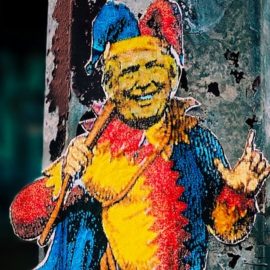

This article is an excerpt from the Shortform book guide to "Alexander Hamilton" by Ron Chernow. Shortform has the world's best summaries and analyses of books you should be reading.
Like this article? Sign up for a free trial here.
When did the Federalist Party end? What triggered the collapse of Federalism?
Federalism slowly began to fizzle out by the end of the 18th century due to the rise of Republican voters and presidents. Ron Chernow’s biography Alexander Hamilton details the fall of Federalism and Hamilton, who was the de facto leader of the party.
Read more about the end of Federalism and Hamilton’s career.
The Slow Collapse of Federalism
When did the Federalist Party end? By the end of the 18th century, Federalism’s popularity was waning. Chernow argues that the party lost all significance under a succession of Republican presidents, beginning with Jefferson’s election in 1800. Though Federalism continued operating for another decade, it had few voters outside of New England. Chernow attributes the party’s collapse to infighting, a series of unpopular measures implemented by Adams, and Hamilton’s own diminishing influence as he was beset by scandal and increasingly out of step with the party line.
Infighting
Chernow describes Adams as an extremely prideful and paranoid figure who, like Jefferson, resented Hamilton’s close relationship with Washington. After Adams took office, his feud with Hamilton became more bitter and personal, as he repeatedly questioned Hamilton’s race and the circumstances of his birth. He also suspected, correctly, that members of his cabinet were Hamilton sympathizers—Chernow notes that Adams’s Secretary of State and Treasury Secretary regularly solicited Hamilton’s advice before writing policy. This led Adams to exclude them from decision-making and ultimately purge the cabinet in his final year in office.
As a result of their rivalry, pro-Hamilton and pro-Adams factions formed within the Federalist party. The issue came to a head with Hamilton’s publication of an anti-Adams pamphlet in 1800. Though it was intended to be read by only a few Federalists, it was soon leaked to the press. Chernow argues that the pamphlet made both Hamilton and Adams look incompetent and petty, as it used private White House documents to highlight Adams’s personal insults against Hamilton, yet ended with an endorsement of his re-election against Jefferson as the lesser of two evils. It’s unclear how much impact the pamphlet had on Adams’s loss, but it further broke down communication between the two factions.
(Shortform note: Hamilton did not intend to hurt Adams’s reelection campaign, but in the years since, sub-groups within political parties have used similar tactics to undermine elections, either in protest of specific figures or of changes to a party’s platform. For example, in 1884, the “mugwumps” switched their votes to Democrat rather than vote for the corrupt Republican candidate James G. Blaine, and in 2016 the Never Trump movement unsuccessfully attempted to block Donald Trump’s nomination with a mix of public personal attacks and proposed revisions to the Republican National Convention’s voting process.)
Unpopular Policies
Public support for American neutrality toward the Britain-France conflict waxed and waned throughout the Adams presidency, but Chernow argues that the tide turned decidedly against the Federalist party with the Alien and Sedition Acts of 1798, passed by the Adams administration but endorsed by Hamilton. These acts were widely interpreted as an authoritarian abuse of power that enabled Federalist persecution of Republicans and immigrants.
The Sedition Act criminalized publishing false information about the government or politicians. While the act’s stated purpose was to cut down on misinformation from the press, which had grown substantially in the 1790s, and to protect politicians from slander, Chernow notes that it was wielded primarily against Republican journalists and newspapers. Legal challenges accused the act of being a form of legalized censorship.
(Shortform note: Defenders of the Sedition Act sometimes argued that journalists encouraged dissension and violence by publishing misinformation. While the Act didn’t survive into the 19th century, similar fears about the power and influence of the news media did—in the 1890s, critics of “yellow” or sensationalist tabloid journalism suggested that it was partially responsible for the US entering the Spanish-American War. Today, research shows that various governments may themselves use internet “troll farms” on social media to spread misinformation or encourage support for particular policies.)
The remaining acts all focused on the rights of recent immigrants to the US, making it more difficult for them to attain citizenship and allowing them to be deported or detained without trial. These policies prompted the emigration of many French citizens living in the US and were widely condemned as prejudiced and undemocratic, not to mention hypocritical on Hamilton’s part, as he had himself emigrated from the Caribbean. Jefferson campaigned on a promise to appeal the acts, and he kept this promise for all but one, the Alien Enemies Act, which allows citizens of a nation the US is at war with to be imprisoned indefinitely without charge. As of 2023, it remains in effect, despite controversy over its use during World War II to imprison Japanese Americans.
(Shortform note: Over a hundred thousand Japanese Americans were imprisoned in concentration camps as potential “alien enemies” between 1942 and 1946. Half of those interned were children, and over two-thirds held US citizenship. Conditions in the camps were poor, and nearly two thousand people died inside, mostly from disease. In the decades since, the US government has issued a formal apology and paid reparations to the surviving former detainees, but the Alien Enemies Act has never been formally challenged, and revisions made to it since 1946 have only expanded its reach.)
Hamilton’s Fall From Grace
Chernow argues that the Adams pamphlet was only one of a series of missteps Hamilton made near the end of his career. Being the de facto head of the Federalist party, Hamilton fell out of favor as the party did, but he also attracted personal condemnation for the Reynolds scandal of 1797. By the time of his death in 1804, Hamilton was an increasingly unpopular figure of waning influence.
Hamilton’s 1791 affair with Maria Reynolds, a married woman, and subsequent blackmail by her husband was the nation’s first sex scandal, revealed by gossip columnist and Republican sympathizer James Callender in a series of pamphlets that accused Hamilton not only of adultery, but also insider trading—conspiring with the Reynolds to use his knowledge of the US economy to buy and sell government bonds at critical times and make a profit. Hamilton retaliated by publishing what became known as the Reynolds Pamphlet, in which he confessed to the affair but denied any financial wrongdoing. Chernow agrees with Hamilton’s summary of events, but he calls the Reynolds Pamphlet a fatal mistake nonetheless.
(Shortform note: Some historians have theorized that Hamilton actually was conspiring with the Reynolds to commit fraud, and the story of the affair was a total fabrication designed to cover his tracks. Callender himself later suggested that the spelling and grammatical errors in Maria Reynolds’ letters (as reproduced in the Pamphlet by Hamilton) were inconsistent and may have been an educated man’s attempt to reconstruct how a less educated woman would write. Skeptics of this theory point out that there’s no evidence for Hamilton laundering money in his financial records and that he was heavily in debt for much of his life.)
By the standards of the day, the pamphlet was shockingly detailed and embarrassing. Chernow notes that many of Hamilton’s allies had advised him to simply ignore Callender’s accusations, and while his confession did not damage his position within the party or his relationship with Washington, it did ensure that he never held public office again. It also made it difficult for Hamilton to criticize other politicians—for example, when he targeted Jefferson, who had his own sex scandal involving the enslaved woman Sally Hemings, Hamilton was accused of hypocrisy.
(Shortform note: Though rumors about Sally Hemings would follow Jefferson for the rest of his life, and sexual violence committed against slaves by slave owners was common in this era, Callender’s claims were largely dismissed by historians until the late 1990s, when a history of the Hemings family published by historian Annette Gordon-Reed and a DNA test conducted on their surviving descendants demonstrated that Jefferson almost certainly was the father of at least four of Sally Hemings’s children, all of whom were born into slavery.)

———End of Preview———
Like what you just read? Read the rest of the world's best book summary and analysis of Ron Chernow's "Alexander Hamilton" at Shortform.
Here's what you'll find in our full Alexander Hamilton summary:
- The biography of Alexander Hamilton that was adapted into the Broadway musical
- The life and influence of the overlooked Founding Father
- How Hamilton's life ended in scandal and a fatal duel






